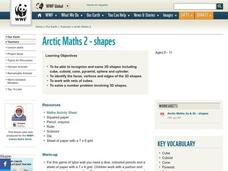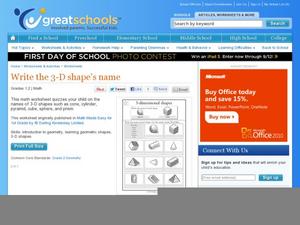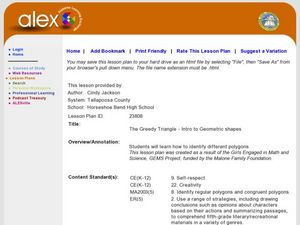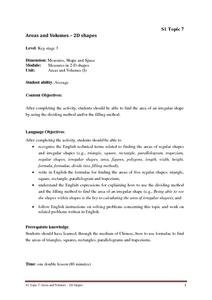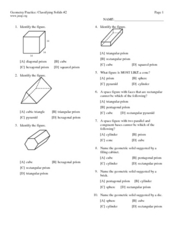Illustrative Mathematics
3-D Shape Sort
From the apple on your desk and the coffee cup in your hand, to the cabinets along the classroom wall, basic three-dimensional shapes are found everywhere in the world around us. Introduce young mathematicians to the these common figures...
K-5 Math Teaching Resources
2-D Shape Cards
Add some visual support to your elementary geometry lessons with this set of printable shape cards. From triangles and squares to octagons and nanogons, this simple resource can be used in countless ways to develop children's knowledge...
World Wildlife Fund
Shapes
Investigate the properties of three-dimensional figures with this Arctic-themed math instructional activity. Beginning with a class discussion about different types of solid figures present in the classroom, young mathematicians are then...
Curated OER
Write the 3-D Shape's Name, Part 2
Geometry can be fun when you know the shapes! Twelve pictures of geometric shapes, including cones, pyramids, and spheres, prompt first graders to write the name of each shape in the space provided. Use the activity as a quiz or homework...
Curated OER
Recognizing 3-D Shapes, Part 2
Take your math lesson to another dimension with this lesson about 3-D shapes! First graders label cones, cylinders, pyramids, spheres, cubes, and prisms, and then count the number of each shape in a collective picture. A great way to...
Virginia Department of Education
Exploring 3-D Geometry
Take young mathematicians on an exploration of the world of 3-D geometry with this seven-lesson unit. After first defining the terms perimeter, area, and volume and how they apply to the real world, students continue on...
Curated OER
Geometry Vases: Ceramics Lesson
Geometric shapes are used in math and in art. Learners discuss the various names, dimensions, and attributes of geometric shapes, then apply that knowledge to design a vase. They use 3-D shapes to make a cubist-style vase out of clay.
Curated OER
Mining Shapes
In this 2-D shapes lesson, kindergarteners review plane shapes attributes. They engage in a shape hunt in the classroom and create art using plane shapes. A good, hands-on lesson!
Math Solutions
Shape Sorting: Looking for Green!
Young mathematicians rotate, flip, and sort their way to an understanding of the different attributes of geometric figures. Using transparent yellow and blue shapes, children try to match congruent figures together...
Curated OER
Recognizing 3D Shapes, Part 3
Do your first graders know the difference between cones and cylinders? Use this handy activity to help youngsters learn geometric shapes. With prisms, spheres, and pyramids, among others, this resource prompts pupils to identify each...
Curated OER
Write the 3D Shape's Name
Can your first graders identify a cone? What about a cube? Or a prism? Help them find the differences between these shapes with this worksheet, which provides a word bank for three-dimensional shapes. For extra practice, bring in...
Curated OER
Shape Up!
An outstanding lesson on teaching the basic shapes and polygon names to young geometers is here for you. In it, learners investigate the role of basic polygons in the strength of structures. They use geoboards, rubber bands, streamed...
Curated OER
Can You Name That Shape?
Learners use materials to build, investigate, and draw two-dimensional shapes (polygons). They combine the shapes they have built and draw from the pile to begin a round-robin activity to name and determine the attributes of a selection...
Curated OER
The Greedy Triangle-Intro to Geometric Shapes
In this geometry lesson, learners read The Greedy Triangle and use geoboards to construct geometric shapes. They identify the number of sides and angles each shape has.
Curated OER
2D Shapes
This engaging presentation would be helpful for your young learners of geometry. Pupils are given clues as to what a shape may be, then they have to use those clues to guess what shape is being described. Shapes used are the circle,...
Curated OER
2-D Shape Recognition
How many of 2-D or plane shapes can your class identify? Can they get them all? Little learners view and review the names of nine different shapes, such as rectangle, square, triangle, and circle, to name a few.
EEWeb
Geometry: Shapes and Solids
An excellent resource for a geometry class, as well as for an electrical engineering course. A thorough reference sheet covers geometric shapes such as triangles, parallelograms, and circles, as well as 3-D shapes and the Pythagorean...
Government of Hong Kong
Areas and Volumes - 2D Shapes
Unfortunately for young mathematicians, the world isn't made entirely of parallelograms, triangles, and trapezoids. After first learning the area formulas for these common shapes, students apply this new knowledge to...
Learner
Solid Shapes
A collection of two lessons, kindergartners will identify two-dimensional shapes in solid shapes. They will develop basic knowledge of the components that make up a sphere, rectangular prism, pyramid, cylinder, cone, and cube. Young...
Concord Consortium
Electron Geometry
It's time to whip your chemistry class into shape! Begin your study of molecular geometry with a colorful, 3-D interactive. The resource shows models of linear, trigonal planar, and tetrahedral molecules.
Royal Society of Chemistry
Shapes of Molecules—Geometry of Central Atom
How is a molecule's shape determined? Explore bond angles, lone pairs, and VSEPR theory through a logic-based activity. Chemists pull together information about the major molecular shapes, then use it to solve puzzles.
Curated OER
Geometry Practice: Classifying Solids #2
In this solids worksheet, students identify the characteristics of solids. They name solids and determine the number of faces. This three-page worksheet contains seventeen problems. Answers are listed on the last page.
Curated OER
3-D Figures Part 1
Elementary schoolers explore 3-D shapes. They transition from thinking of shapes as only 2-D. Pupils read Cinderella as a launching activity for their upcoming adventure, and explore a new world of 3-D shapes in this introductory lesson.
Curated OER
Shapes: Art or Geometry
Budding artists or mathematicians read about,and then draw, two very different shapes. Geometric and organic 2-D shapes are defined. Learners use the definitions to draw examples of each.


